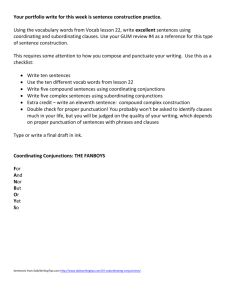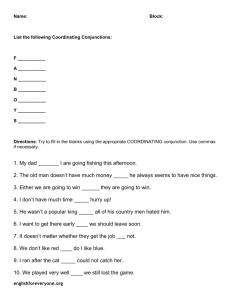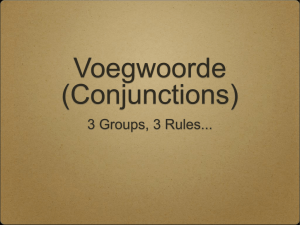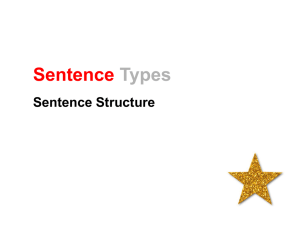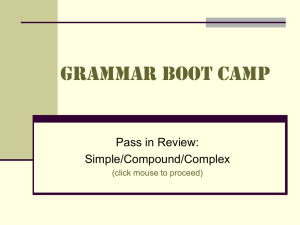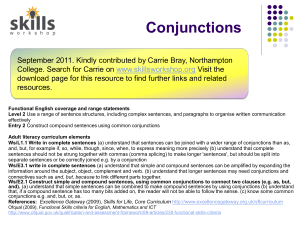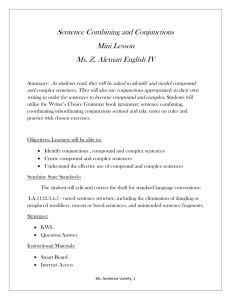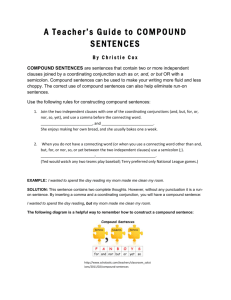Compound Sentences
advertisement
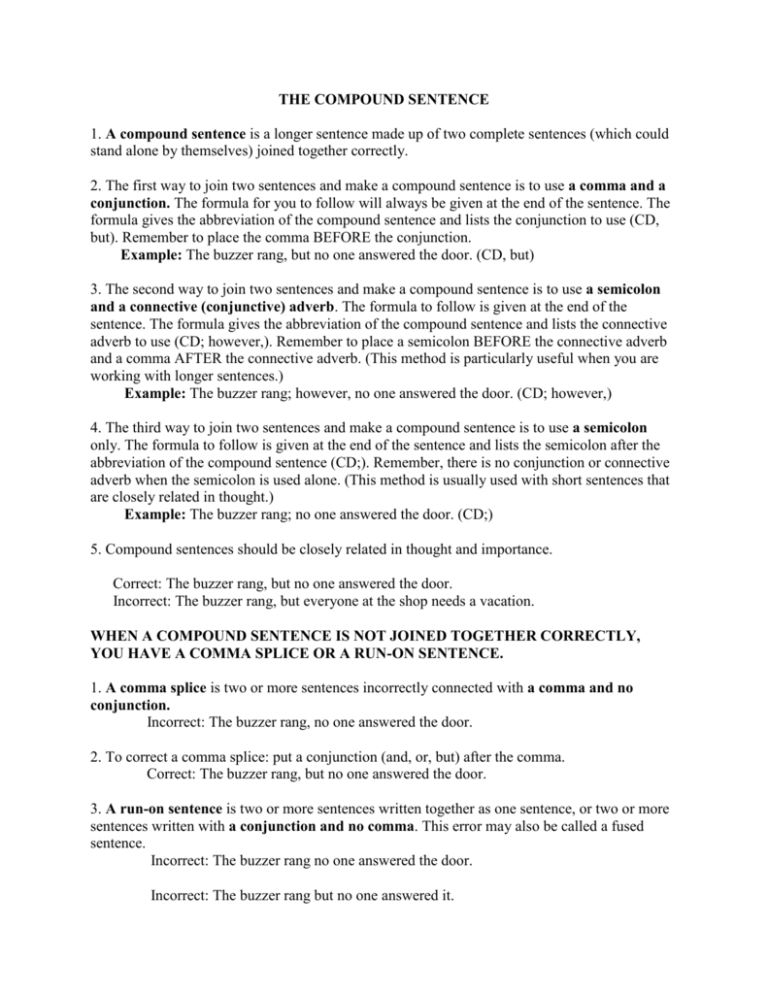
THE COMPOUND SENTENCE 1. A compound sentence is a longer sentence made up of two complete sentences (which could stand alone by themselves) joined together correctly. 2. The first way to join two sentences and make a compound sentence is to use a comma and a conjunction. The formula for you to follow will always be given at the end of the sentence. The formula gives the abbreviation of the compound sentence and lists the conjunction to use (CD, but). Remember to place the comma BEFORE the conjunction. Example: The buzzer rang, but no one answered the door. (CD, but) 3. The second way to join two sentences and make a compound sentence is to use a semicolon and a connective (conjunctive) adverb. The formula to follow is given at the end of the sentence. The formula gives the abbreviation of the compound sentence and lists the connective adverb to use (CD; however,). Remember to place a semicolon BEFORE the connective adverb and a comma AFTER the connective adverb. (This method is particularly useful when you are working with longer sentences.) Example: The buzzer rang; however, no one answered the door. (CD; however,) 4. The third way to join two sentences and make a compound sentence is to use a semicolon only. The formula to follow is given at the end of the sentence and lists the semicolon after the abbreviation of the compound sentence (CD;). Remember, there is no conjunction or connective adverb when the semicolon is used alone. (This method is usually used with short sentences that are closely related in thought.) Example: The buzzer rang; no one answered the door. (CD;) 5. Compound sentences should be closely related in thought and importance. Correct: The buzzer rang, but no one answered the door. Incorrect: The buzzer rang, but everyone at the shop needs a vacation. WHEN A COMPOUND SENTENCE IS NOT JOINED TOGETHER CORRECTLY, YOU HAVE A COMMA SPLICE OR A RUN-ON SENTENCE. 1. A comma splice is two or more sentences incorrectly connected with a comma and no conjunction. Incorrect: The buzzer rang, no one answered the door. 2. To correct a comma splice: put a conjunction (and, or, but) after the comma. Correct: The buzzer rang, but no one answered the door. 3. A run-on sentence is two or more sentences written together as one sentence, or two or more sentences written with a conjunction and no comma. This error may also be called a fused sentence. Incorrect: The buzzer rang no one answered the door. Incorrect: The buzzer rang but no one answered it. 4. To correct a run-on sentence: 1. Put a comma and a conjunction between the two complete thoughts. 2. Put a semicolon and a connective adverb between the two complete thoughts. 3. Put a semicolon between the two complete thoughts. Correct: The buzzer rang, but no one answered the door. Correct: The buzzer rang; however, no one answered the door. Correct: The buzzer rang; no one answered the door. As you have just learned, compound sentences are correctly joined with conjunctions and connective adverbs. Now you will learn more about coordinate conjunctions. COORDINATE CONJUNCTIONS You have already learned that conjunctions join words or groups of words together, and the three most common conjunctions are and, or, and but. Since there are different kinds of conjunctions, you will now learn the name of conjunctions that join. Conjunctions that join are called coordinate conjunctions or coordinating conjunctions. Coordinate conjunctions join things of equal importance, like compound subjects, compound verbs, or compound sentences. The conjunctions and, but, or, nor, yet, and for are coordinate conjunctions. They join together words, phrases, or sentences that have equal importance. Sometimes, the word so is used as a coordinate conjunction. You will know to use so as a coordinate conjunction if it means as a result. Do not use so as a coordinate conjunction if you can substitute "so that” as you read the sentence. Examples: We have a new car, so we are happy. We arrived early so (that) we could get a good seat. It is easy to remember the seven coordinate conjunctions because their first letters spell out FAN BOYS: For, And, Nor, But, Or, Yet, So. The coordinate conjunctions and some of the connective adverbs are listed below to help make it easy for you to use them. Type of Conjunction/Adverb More Information Contrast/Choice Alternative Coordinate Conjunctions Connective Adverbs and nor for moreover furthermore besides also likewise but yet however nevertheless or otherwise As a result so therefore hence thus consequently accordingly
